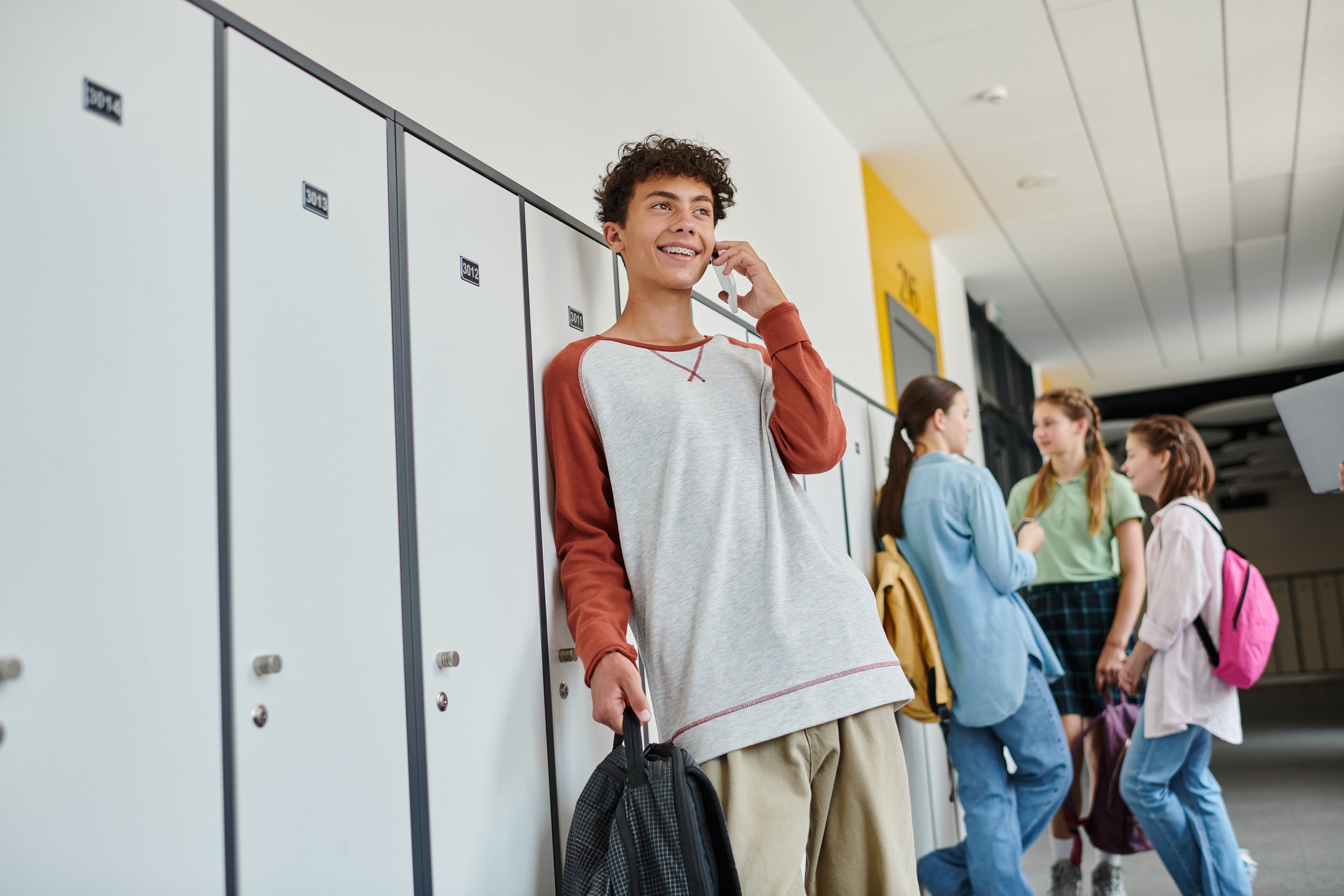As cell phones become a constant presence in students' lives, their role in the classroom is a growing topic of discussion. And with 97% of teens using their phones during school hours, educators face a critical question: are these devices enhancing learning or creating distractions?
While cell phones have the potential to support education, they may lead to more interruptions than productivity. While students may use their phones for educational purposes, excessive phone use can also disrupt classroom focus and hinder collaboration.
A well-designed cell phone policy can address these challenges and even turn phones into productive tools for learning. Keep reading to learn how to create and communicate effective guidelines for implementing a cell phone policy in your district or school.
Why Your District Needs a Cell Phone Policy
Having cell phones and smartphones in schools presents districts with a unique opportunity to enhance learning. These devices can provide access to educational apps, improve accessibility, and support the teaching of digital literacy—a critical life skill for the modern world.
By developing a thoughtful cell phone policy with input from teachers, staff, families, and students, schools can maximize the benefits of these devices while mitigating potential challenges. Here are the key reasons why establishing clear guidelines for mobile device use can benefit schools:
- Minimizing Classroom Distractions: Having a phone out during class or even hearing it buzz frequently can distract both students and their peers. Implementing a policy that limits non-educational use helps foster a focused and productive learning environment.
- Mitigating Risks of Cyberbullying: Reports indicate that 42% of students have experienced online bullying, with nearly one in four encountering it more than once. A thoughtful cell phone policy can promote digital citizenship skills, encouraging students to practice good digital etiquette, prevent cyberbullying, and stay safe online.
- Addressing Mental Health Concerns: Teens who spend over three hours per day on social media are 200% more likely to experience some level of depression. Clear policies and guidelines for safe and appropriate cell phone use can help reduce anxiety and social pressures, promoting healthier habits and balanced internet activity.
- Encouraging Responsible Phone Use: Understanding how to use a smartphone responsibly is a critical skill for adulthood. By establishing clear expectations for appropriate mobile device use, schools can foster responsible habits and encourage respectful digital communication.
- Staying Aligned with Regulations: Implementing a standardized cell phone policy ensures your school can quickly and consistently adapt to new federal and state guidelines, helping to maintain compliance and streamline practices across the district.
- Ensuring Standardized Implementation: A well-designed cell phone use policy is essential for fostering a fair and inclusive learning environment. Clear and consistent rules help set uniform expectations for all students during school hours.
4 Major Components of a Strong Cell Phone Policy
Defining clear boundaries for cell phone use creates an opportunity for schools to foster focus, engagement, and responsible technology habits among students. By implementing a thoughtful cell phone policy, schools can align expectations, encourage positive behavior, and teach valuable digital citizenship skills. Here are four best practices for setting up effective mobile device guidelines:
Set Expectations for Students
Clearly define the acceptable times and locations for cell phone use in your school, including guidelines for classrooms, hallways, and cafeterias. Specify whether students are permitted to use their phones during extracurricular activities and school-sanctioned events. Additionally, provide clear instructions on where phones should be stored during class, such as in lockers, backpacks, or phone-locking pouches, to ensure consistency and minimize distractions.
Set Expectations for Visitors and Guests
Your cell phone use policy should also include guidelines for visitors on school grounds. Applying consistent rules for everyone—students, staff, and guests—helps ensure that visitors understand and follow expectations for phone use during events, visits, and meetings. This reinforces the school’s commitment to minimizing distractions and maintaining a focused and productive learning environment.
Welcome Input From Stakeholders
Creating effective cell phone policies starts with understanding the unique needs and priorities of your school community. This is where feedback surveys become invaluable. Surveys provide district leaders with direct insights from key stakeholders—students, families, and educators—about how cell phones impact learning, well-being, and classroom management. By collecting feedback, leaders can identify areas of concern, gauge support for potential policies, and ensure everyone’s voice is heard in the decision-making process.
Assess and Adjust Over Time
Having a cell phone policy in place is only the first step. Schools should collect data after implementing a policy to evaluate its impact. Regularly assess your policy’s effectiveness by gathering feedback from students, families, and staff. Use this input to identify areas for improvement, address new challenges or technologies, and ensure alignment with district guidelines. This continuous review process helps keep the policy relevant and effective in supporting a positive learning environment.
How to Develop a Cell Phone Policy
Designing and implementing a school-wide cell phone policy may seem daunting, but breaking the process into clear steps can make it more manageable. Here are practical strategies district and school leaders can use to ensure cell phone use supports acceptable behaviors and enhances the learning environment:
- Map Common Phone Use Cases: Identify potential scenarios, such as using phones during emergencies, for classroom research, or during breaks. Tailor your rules to address these specific needs, ensuring the policy is practical and aligns with how students and staff use their devices.
- Define Zones of Usage: Designate specific areas where phone use is permitted, restricted, or conditional. For example, allow usage in the cafeteria during lunch, restrict it in classrooms during instructional time, and make it conditional in spaces like the library to maintain a quiet environment.
- Set Parameters for Academic Use: Clearly outline when and how phones can be used to support learning activities. For instance, specify approved apps, online resources, or tools that can enhance instruction and define appropriate times for their use in the classroom.
- Identify Non-Academic Use: Clearly distinguish between acceptable and unacceptable cell phone use during school hours. For example, appropriate uses might include calling home in an emergency, accessing school-related research, or using productive apps. Conversely, activities like social media browsing, gaming, or idle texting should be explicitly defined as off-limits.
- Establish Notification Practices: Set clear rules for managing notifications to minimize disruptions. For example, require students to silence their phones or enable "Do Not Disturb" mode during class and other designated times to maintain a focused and respectful learning environment.
- Create Visual Reminders: Display phone usage rules prominently in key areas using posters, digital signage, and student handbooks. Clear, visible reminders in classrooms, hallways, and common spaces help reinforce expectations and ensure consistent adherence to the policy.
- Pilot Technology-Free Zones: Introduce designated spaces, such as tech-free lunch areas, to encourage face-to-face social interaction and provide a balance between device use and personal engagement. Use these pilot programs to gather feedback and assess their impact on the school environment.
- Gather Feedback on Specific Rules: Regularly consult teachers, staff, families, and students to evaluate the effectiveness of phone-related rules. Their insights can help identify what’s working, what needs adjustment, and how the policy can better meet the needs of the school community.
Using Panorama Surveys to Create Effective Policies
To prevent distractions and maximize the educational benefits of cell phones, schools must lead the way in fostering responsible use through well-defined policies. Developing these policies requires input from all stakeholders in a practical and transparent way. However, gathering this feedback can be challenging without the right tools. That’s where Panorama comes in to support schools with effective survey solutions.
Panorama’s Cell Phone Impact and Policy Survey is here to help. With the right questions and actionable insights, you can design policies that meet the unique needs of your schools and ensure they’re working as intended. Download the survey now and start building a stronger foundation for technology use in your district.







